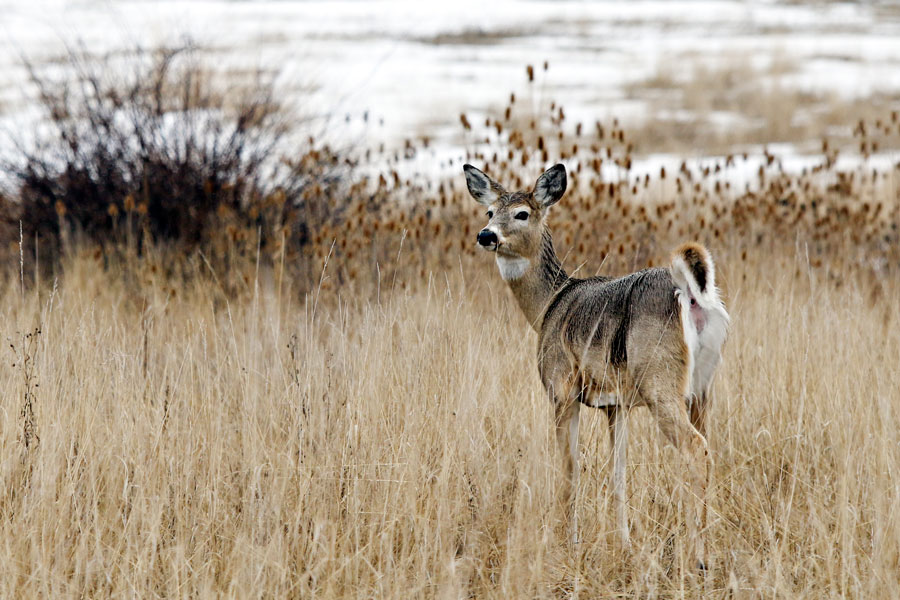For the first time since Chronic Wasting Disease (CWD) was detected among Montana’s wild, free-ranging deer populations in 2017, the fatal neurological illness has arrived in the Flathead Valley, turning up in a captive game farm animal earlier this month.
The confirmation, announced Nov. 20 in a news release from the Montana Department of Livestock, provides further proof of CWD’s growing presence in Montana, where the neurological disease has become widespread in some areas of the state.
However, the recent detection marks the first time CWD has been confirmed in Northwest Montana outside of the Libby area, where it has been gaining prevalence since 2019.
The local detection was made at a game farm in the Flathead Valley, though the Department of Livestock is withholding the precise location and the type of animal that tested positive in order to protect the property owner’s identity. When pressed on those details, Livestock officials explained that Montana law prohibits the release of more specific disclosures in the hope of encouraging greater public participation in voluntary disease testing programs.
CWD was first detected in captive game farms in Montana in 1999. The following year, a voter’s initiative passed banning new game farms, prohibiting existing game farms from being sold or transferred, and outlawing “canned” hunts inside game farms. Montana’s remaining game farms are “grandfathered in,” officials said, including the “alternative livestock producer” in the Flathead.
The CWD positive animal in the Flathead was found as a result of a mandatory surveillance program that targets game farm mortalities in Montana, officials said. The state’s CWD Herd Certification Program requires that all animals older than 12 months are tested. The CWD positive animal was not exhibiting any clinical signs of CWD but was found dead on the affected premises, according to Assistant State Veterinarian Dr. Tahnee Szymanski.
“What we know about our Flathead case is that it has been a very long time since this producer has moved any new animals onto the property, and the state of Montana has a mandatory procedure requiring that any animals that die or are slaughtered be tested for CWD,” Szymanski said, though she declined to provide specifics about the case. “The herd in Flathead County has a good history of participating in the required surveillance program, so this case is probably the result of a new animal moving in on its own, or the other thing we know about CWD is that materials can get moved around, so it’s possible a scavenger bird might have transported some infected prion materials onto the property.”
This is the second detection of CWD in domestic cervids in Montana this year, with the first occurring in an elk in eastern Montana. In that case, officials identified the animal but not the county where the case occurred, steps they again attributed to the state privacy law.
Nick Gevock, conservation director of the Montana Wildlife Federation, said the positive CWD case in 1999 is what prompted his organization to wage a campaign against game farms because of their prominent role in spreading disease.
“CWD was absolutely one of the main catalysts for that ballot initiative,” Gevock said. “Any time you concentrate animals like that it’s a recipe for the spread of CWD and other diseases. We have seen this in other states where people are moving around CWD-positive animals, and they intermix with free-ranging public wildlife. It’s not hunting, it’s turning wildlife into livestock and that is why Montana Wildlife Federation is proud that we led the campaign to get rid of game farms in Montana.”
The Flathead County infection was confirmed by the National Veterinary Services Laboratories in Ames, Iowa, through the identification of the prion in tissue samples collected from the animal, officials said.
The Livestock Department has placed the herd under quarantine and is conducting an epidemiological investigation, according to the news release. Montana law requires CWD positive game farm herds to undergo complete depopulation and post-mortem testing of the herd, or quarantine of the entire herd for a period of five years from the last CWD positive case.
“An epidemiologic investigation will be conducted, but at this time, the source of the disease is unknown,” State Veterinarian Dr. Marty Zaluski stated in the press release.“We will look at historical animal movements associated with this captive herd and proximity to infected wildlife to try to determine the source of exposure.”
Montana Fish Wildlife and Parks (FWP) has documented CWD in wild cervids across much of Montana through surveillance that began in 2017. In 2019, FWP sampled 7,000 wild deer, elk, and moose across the state, focusing on high-priority areas like the Hi-Line, the Philipsburg area, southeastern Montana, and the Libby area. Of the samples, 144 tested positive for the fatal disease, including 53 mule deer, 88 white-tailed deer, two moose and one elk. These were Montana’s first detections in moose and wild elk.
In 2019, a white-tailed doe in the Libby area marked the first time the disease had been detected west of the Continental Divide in Montana. In response, FWP set up a priority surveillance area surrounding Libby and detected 60 positive cases in the area, almost exclusively in white-tailed deer.
